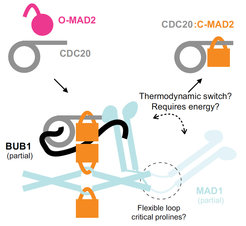The structural flexibility of MAD1 facilitates the assembly of the Mitotic Checkpoint Complex
Chen C, Piano V, Alex A, Han SJY, Huis In 't Veld PJ, Roy B, Fergle D, Musacchio A, Joglekar AP.
Nat Commun. (2023)
Here, the Musacchio group together with the Joglekar group from the University of Michigan demonstrate that the structural flexibility of MAD1 at a conserved hinge near the C-terminus is essential for catalyticMCCassembly. ThisMAD1 hinge enables theMAD1:MAD2 complex to assume a folded conformation in vivo. Importantly, truncating the hinge reduces the rate of MCC assembly in vitro and SAC signaling in vivo. Conversely, mutations that preserve hinge flexibility retain SAC signaling, indicating that the structural flexibility of the hinge, rather than a specific amino acid sequence, is important for SAC signaling.
These observations are summarized as the ‘knitting model’ that explains how the folded conformation of MAD1:MAD2 promotes CDC20:MAD2 assembly.
Here, the Musacchio group together with the Joglekar group from the University of Michigan demonstrate that the structural flexibility of MAD1 at a conserved hinge near the C-terminus is essential for catalyticMCCassembly. ThisMAD1 hinge enables theMAD1:MAD2 complex to assume a folded conformation in vivo. Importantly, truncating the hinge reduces the rate of MCC assembly in vitro and SAC signaling in vivo. Conversely, mutations that preserve hinge flexibility retain SAC signaling, indicating that the structural flexibility of the hinge, rather than a specific amino acid sequence, is important for SAC signaling.
These observations are summarized as the ‘knitting model’ that explains how the folded conformation of MAD1:MAD2 promotes CDC20:MAD2 assembly.

